Take a moment, and close your eyes. Breathe deeply, and inhale the salt of the air and feel the light brush of low-hanging tree branches caressing your face. Feel the rocky ground beneath your toes, prickly but comforting, as you follow the path you’ve walked thousands of times. Step into the darkness of the nearest cave, the coolness of the cavern chased away by a low burning fire. Turn your eyes upward and pause. Startling white shines down on you from the upper region of the caves, a warm, sunny palette of red and yellow warming your face within the recess. Rich, coppery red mixes with faded yellow, and black figures begin to dance before your eyes.
These are the cave paintings of the Chumash tribe.
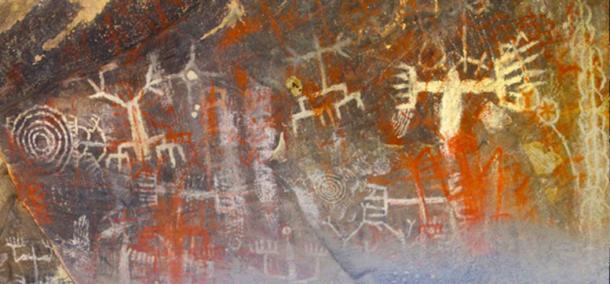
Chumash Cave Paintings in the Burro Flats Painted Cave, Simi Valley, California, USA. ( CC BY SA 4.0 )
The Chumash People
The Chumash people are one of many Native American tribes that once dominated what is now the USA. Located in modern day Santa Barbara, California, between the coast and the Santa Ynez Mountain range, the Chumash called themselves “the first people,” believing the Pacific Ocean was their “first home”. Scholars have determined the Chumash resided in this region for at least 11,000-13,000 years, thriving for such a long time in the same location due not only to their proximity to the sea, but also the fertility of the land between the mountains.
Lining the coast for such an extensive period of time, the Chumash grew with the sea, and are distinguished for utilizing the redwood trees of the region to build boats far more advanced than those of their neighbors. While the medieval Vikings of northern Europe used their own remarkable building abilities to conquer other, less powerful groups of people, the Chumash utilized similar skills to create a form of transportation that allowed them not only to regulate the various villages within their tribe, but likely to spread the cultural artistry that now defines the southwestern coast of California as well. According to the modern website of the Chumash in Santa Ynez, they “once numbered in the tens of thousands”, spanning “7,000 square miles” (18129.92 sq. km) of the California coast.
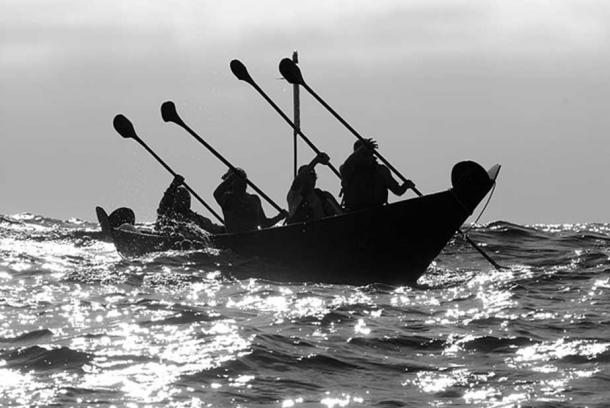
Chumash Tomol ‘Elye’wun paddlers crossing at Santa Cruz Island. California, Channel Islands NMS, Santa Cruz Island. (Robert Schwemmer, CINMS, NOS, NOAA/ CC BY 2.0 )
The Vast Network of Cave Paintings
Though these boats are quite distinctive among the Chumash, undoubtedly the most significant aspect of their culture is their vast network of cave art that line the coast of California. Dating reveals that most of the paintings are likely less than 1,000 years old (though some are much, much older), but this time frame must be taken with care. The process of radiocarbon dating is not yet 100% definitive.
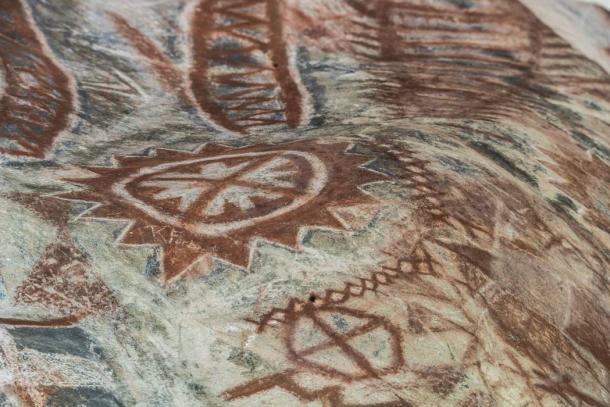
Chumash cave paintings, detail. ( David /Adobe Stock)
Based on archaeological evidence, the Chumash initially used charcoal to make their marks in these naturally carved stone shelters. Over time, the Chumash learned to create pigments that had a lasting effect on the rock, creating vibrant images that survive alongside the black charcoal ones. Red, yellow, and white dominate the cave images, made from other ground natural materials such as red ocher or hematite (red) and gypsum (white). While the Chumash were also very skilled in basketry and bead jewelry, their paintings (like their advanced ship-making abilities) distinguish them best from neighboring tribes.
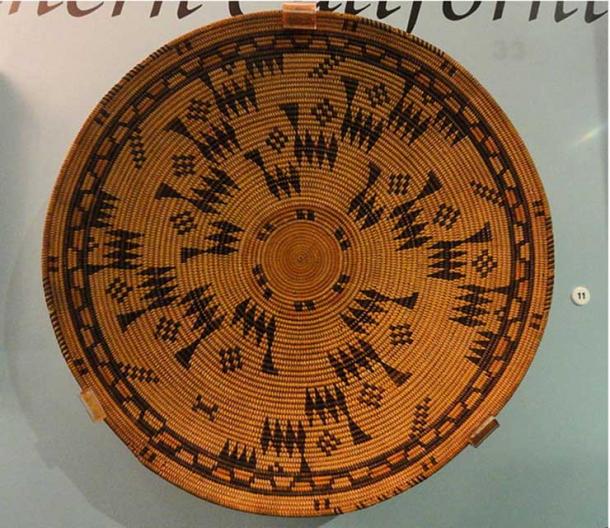
Basketry tray, Chumash, Santa Barbara Mission, early 1800s. ( Public Domain )
Significance of the Cave Paintings and Rock Art Creations
Interestingly, it appears that the Chumash decorated these caves as part of the religious ceremonies scholars have associated with these locations: in various ancient religions, caves are considered doorways to another realm. The Picts in early medieval Scotland frequented coastal caves, leaving similar drawings, and it is similarly believed these markings were for religious purposes. A plethora of evidence also survives for such beliefs in ancient and medieval Ireland.
Though the Picts left no translatable documents, Irish texts survive that discuss the Mound of the Hostages within the Hill of Tara (near Dublin), a place once believed to be an entrance to the mythological Otherworld. Thus, the discovery of paintings in the Chumash caves (when examined in conjunction with surviving literature and oral histories) indicates the likelihood that the paintings were, in fact, intended for religious purposes. Further, recent linguistic research indicates that the Chumash referred to those who created the rock art as the tribe’s shamans.
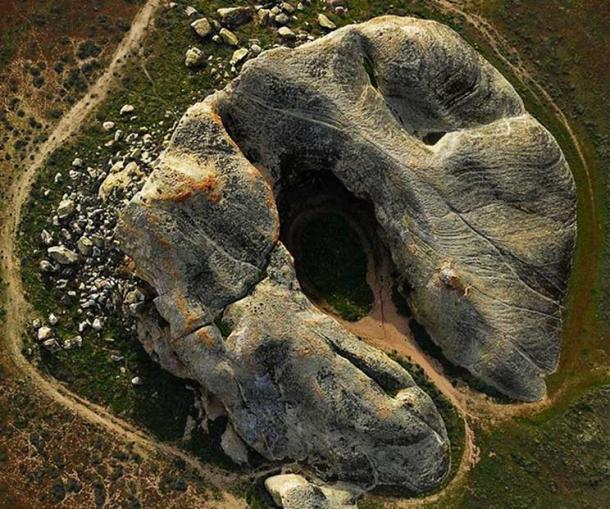
Aerial view of Painted Rock. The interior alcove of the horseshoe-shaped rock features pictographs by Chumash, neighboring tribes, and non-Native Americans. (John Wiley/ CC BY 3.0 )
When examining evidence from other cultures who emphasized religious rock art, it is possible to suggest these paintings had a meaning beyond merely depicting mythological events or family histories. It was common in some cultures (such as the Andean cultures of Paracas and Nazca in South America) for shamans to take hallucinogenic drugs to create an altered consciousness through which they could speak to the spirits, called vision quests. These communications were then often recreated in textiles or other art forms. It has been theorized that the cave paintings of the Chumash are such recordings, as they are depicted within a natural area associated with the supernatural.
Other theories suggest that these images are part of rituals requesting fruitful harvests and an abundance of rainfall, as well as extensive fertility among the men and women. Though the specific meaning of the pictographs remains uncertain, it is agreed by most scholars that they are more than just the drawings of idle tribesmen.
A Chumash Legacy
It is lucky that the Chumash chose to commemorate so much of their culture in charcoal and mineral pigments. While oral tales have survived numerous retellings, the Chumash suffered a devastating blow to their population in the 18th and 19th centuries. Spanish expeditions made their way to the Chumash’s territory around 1769 and spread new, unheard of diseases among the native population…a tragedy that tends to happen in history when Europeans decide to leave the comfort and quiet of their own lands.
Despite the fact that the rock art is not as precisely translatable as other forms of record keeping, a working knowledge of Chumash traditions in conjunction with historical and religious uses of art within caves allows for intriguing speculative theories as to the purpose of the art within the Chumash culture.
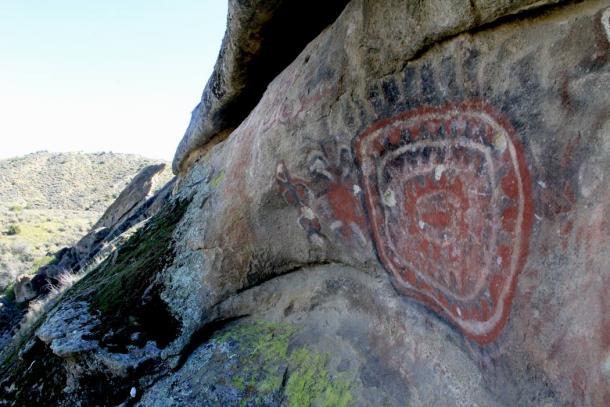
Chumash Rock Art. ( Chuck /Adobe Stock)
Top Image: Chumash cave paintings. Source: David /Adobe Stock
Updated on September 4, 2020.
References
Arnold, Jeanne E. (ed.) 2001. The Origins of a Pacific Coast Chiefdom: The Chumash of the Channel Islands. Salt Lake City: University of Utah Press.
Biehl, P. & Bertemes, F. 2001. The Archaeology of Cult and Religion: An Introduction . In P. Biehl, F. Bertemes, & H. Meller, eds. The Archaeology of Cult and Religion . Budapest: Archaeolingua. pp. 11–26.
California State Parks. 2017. “Chumash Painted Cave.” State of California. Accessed June 24, 2017. http://www.parks.ca.gov/?page_id=602
Dowson, T.A. 1998. “Rock Art: Handmaiden to the Studies of Cognitive Evolution.” In C. Renfrew & C. Scarre, eds. Cognition and Material Culture: the Archaeology of Symbolic Storage . Cambridge: McDonald Institute for Archaeological Research. pp. 67–76.
Droogan, J. 2012. Religion, Material Culture and Archaeology , London: Bloomsbury.
Gamble, Lynn H. 2002. “Archaeological Evidence for the Origin of the Plank Canoe in North America”. American Antiquity . 67.2. pp. 301–315.
Kroeber, A. L. 1925. Handbook of the Indians of California . Bureau of American Ethnology Bulletin No. 78. Washington, D.C.
Meighan, Clement W. “Rock Art on the Channel Islands of California.” Pacific Coast Archaeological Society Quarterly . 36.2. pp. 15-29.
Pritzker, Barry M. 2000. A Native American Encyclopedia: History, Culture, and Peoples . Oxford: Oxford University Press.
Quinn, C.P. & Kuijt, I., 2013. The tempo of life and death during the Early Bronze Age at the Mound of the Hostages, Tara. Tara – From the Past to the Future , (January 2016), pp.196–206.
Santa Ynez Band of the Chumash Indians. 2009. “Chumash History.” Accessed June 26, 2017. http://www.santaynezchumash.org/history.html
Simpson, J.Y. 1867. Archaic Sculpturings of Cups & Stone Circles, etc, upon Stones & Rocks in Scotland, England & Other Countries , Edinburgh.
Waddell, J., 2014. Archaeology and Celtic Myth. Dublin: Four Courts Press.
Related posts:
Views: 0
 RSS Feed
RSS Feed

















 September 5th, 2020
September 5th, 2020  Awake Goy
Awake Goy  Posted in
Posted in  Tags:
Tags: 
















